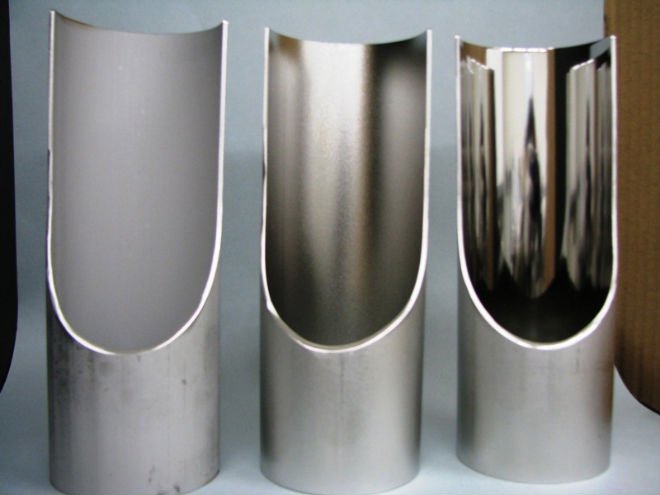by Derek Hogue on June 20, 2013

Ever since its discovery in 1912, stainless steel has been a staple in many industries. Doctors and nurses rely on it in sterile environments, and heating, ventilation and air conditioning workers and designers use it because its surface is nearly impervious to corrosion in the moist environment so prevalent in the HVAC industry. Other fairly wet professions, such as plumbing or farming, depend on it for the same reasons.
Stainless steel is resistant to rust because it forms a protective layer of exceptionally thin corrosion on the chromium that makes up at least 10.5 percent of any stainless steel alloy. Because chromium corrosion does not perpetuate itself like pure iron oxidation, it does not damage the underlying alloy. Rather, it protects the alloy from other, more destructive forms of oxidation. Stainless passivation is a method to reinforce this already naturally occurring process.
In order to conform to industry standards ASTM A967 and AMS 2700, passivated stainless steel must go through a series of tests in order to determine the efficacy of the passivation. Specification AMS 2700 covers all processes designed to dissolve possibly harmful materials from the surface of corrosion-resistant metals such as stainless steel. ASTM A967 governs the testing of such materials after full passivation in a nitric acid bath. Those tests include the following:
- Water Immersion
- High Humidity
- Salt Spray
- Copper Sulfate
- Potassium Ferricyanide–Nitric Acid
- Damp Cloth
Fully passivized stainless steel may be of two types: austenitic and martensitic. Austenitic stainless steel is softer than martensitic, about 400 Brinell, and nonmagnetic. Martensitic stainless steel, with its rapidly-quenched, crystalline construction, is much harder than austenitic stainless steel, about 700 Brinell, and is also magnetic. While some industries need enormous sheets or parts of stainless steel, others require minuscule, intricate structures. Extremely small parts require ultrasonic generators applied to the nitric acid bath in order to passivize all the tiny crevices in such parts.
Derek Hogue is a Milwaukee based expert in electroplating and metal finishing. There is nothing about the process of electroplating, passivating and powdercoating that he doesn’t know. He also believes that if you are looking for metal finishing solutions, you should always work with the best. He recommends working with Artistic Plating if you are looking for such solutions. When he is not working, you can find him fishing with his friends.
by Derek Hogue on April 25, 2013

Professionals in a wide range of industries rely on stainless steel on a regular basis. This includes such industries as the medical, aerospace, and industrial fields as well as plumbing, ammunition, and agricultural fields. Not to mention, a number of industries–and their subsequent customers–in between rely on quality, durable stainless steel in order to create the products that make the world go ’round. Before stainless steel can be used industrially, however, it must be cleaned and coated to ensure that it is well protected from rust, oxidization, corrosion, and other elements that can lead to damage of the steel in the long term.
The process of coating and protecting stainless steel is known as stainless steel passivation. Specifically, this essentially involves carefully and skillfully dipping the steel into a specific combination of acid as a way of removing impurities such as oils and greases from the surface of the steel itself. Once this is done, a protective layer can adequately develop over the surface of the steel to keep it from being exposed to rust, corrosion, and other damage from outside elements. This allows the steel to last for a long time to come, increases its structural integrity and durability, and leads to a longer lasting and higher quality product to be made from the steel as well.
As a result, having stainless steel professionally passivized is an important step for any industrial manufacturer to take, especially when it comes to producing quality products that customers will want to use or continue to purchase for many years to come. Without taking the time to have the passivation process completed, the stainless steel can easily become prone to corrosion and rust. Not only can this detract from the aesthetic appeal of the product itself, but in some cases it can even pose a significant safety risk. This is especially true in stainless steel products that have moving parts.
Clearly, it is imperative that any business working with stainless steel take the time and additional steps necessary to have passivation done. It may cost a bit more money in the short term, but by finding a reliable and affordable company to perform the process correctly, it will be more than worth it in the long run. Such a company will ensure that the steel is properly cleaned prior to beginning the process. This cleaning process is extremely important in making sure that the acid bath is most effective and that the protective coating can thus completely form. From there, business owners an enjoy the peace of mind in knowing that the steel they are working with is of the highest quality and utmost durability.
Derek Hogue is a Milwaukee based expert in electroplating and metal finishing. There is nothing about the process of electroplating, passivating and powdercoating that he doesn’t know. He also believes that if you are looking for metal finishing solutions, you should always work with the best. He recommends working with Artistic Plating if you are looking for such solutions. When he is not working, you can find him fishing with his friends.


